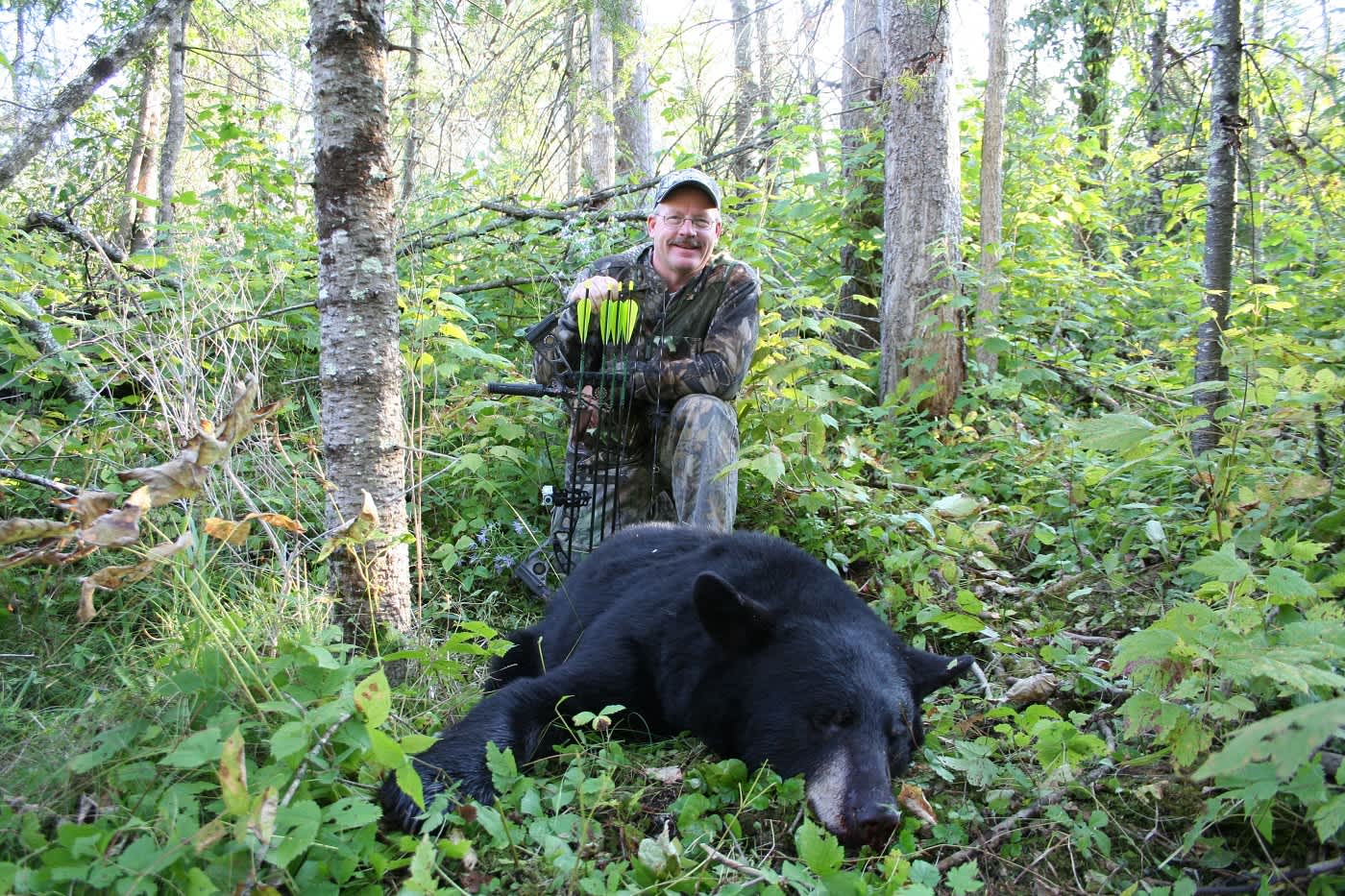Tips for Choosing a Premium Bear Bait Location
Bernie Barringer 08.13.13

The bear turned broadside and I looked down at my 14-year-old son Sterling, who was sitting in a separate treestand just below me. I was about to whisper that he should draw his bow and take the first available shot. I was surprised to see that he was already drawn and he was settling the sight pin on the bear’s side. I looked back into my video camera’s viewfinder just in time to watch the arrow zip through the bear.
Within five to six seconds, the bear was piled up only 40 yards from the bait and we heard the death moan that confirmed what I already knew–the shot had been perfect.
This was the third bear we had bagged off this particular bait in the past few years, and it’s one of my most consistent producers. Interestingly, the bait was once located about 75 yards from where it is now. I moved it a few years ago to locate it in a little thicker cover and to put the setting sun behind the stand instead of in the eyes of the hunter. Those little adjustments made all the difference.

People who are not familiar with bear baiting often think that it’s as simple as dumping a pile of donuts in front of a treestand. Truth be told, there is a lot of science in being consistently successful in baiting bears, particularly in areas where there is a lot of hunting pressure and the bears have several baits to choose from. Let’s take a look at strategies for choosing a productive bait location, from choosing a general area and then narrowing it down to the specific spot where you are eventually going to shoot your bear.
When choosing a general area to bait bear, few people realize the importance of the availability of water. In the late summer and early fall, bears have their heavy fur coats and a thick layer of fat. It’s hard for them to stay cool so they use water daily. Not just to drink but to lie in and cool off. Bears will never be far from water during the summer. Keep this in mind when choosing your location because the father they have to travel from their bedding area to the bait the less likely they will show up there during legal shooting hours.
Additionally, you want to look for areas with natural foods such as berries, acorns, choke cherries, or wild apples. The bears know where the natural foods are found and they will be in the area.
The third component is the proximity to roads and other human activity. Large blocks of timber with little to no access tend to attract bigger mature bears that prefer not to be disturbed by humans. That includes ATVs and hikers. The father from the road you are, the better your chances of getting a big bear on your bait.
Once you have spent some time with maps and Google Earth looking at potential areas, narrow it down to a specific site where you are going to locate your bait. I like to look for natural funnels. Ideally, a narrow corridor of forest between two large swamps or beaver ponds will naturally funnel travelling bears into your site.
Look also for areas where corridors of heavy cover meet. Bears do not like to expose themselves and will avoid travelling through open areas either without trees or with thick overhead tree canopies that leave little sunlight for ground cover. Our objective is to make the bear feel comfortable enough to move about during the daylight. That is done by locating the bait in areas where they can approach with adequate concealment.

Of course you need to choose a place with a good tree for a treestand. Background cover to break up your outline is important. You do not want to have open sky behind you, which makes it easier for a bear to pick out the slightest movement. Keep wind direction in mind, along with the direction of the setting sun. If you have a setting sun behind you, it makes it a lot easier to see the bear for those shots during the last minutes of daylight. No stand is going to have all the perfect elements, so choose locations that offer the best you can get. I like to have about three sites so I have options depending on the wind direction.
Now that you have chosen your location, you must trim shooting lanes ruthlessly. Use the brush you trim from the areas between your stand and the bait to build a makeshift backstop that will make the bear come in from the sides of the bait. That increases your chances of getting a broadside shot.
Taking care to choose a general hunting area and a specific bait site will go a long way towards bringing bears into your baits. Over time, you may have to tweak it a little to get it just right, such as I did with that site where my son shot his first bear. I have no doubt it won’t be the last bear we shoot at that location. I am always looking for more spots just like it!
Next week we will discuss baiting strategies with regard to how often you should bait and how much you should put out at a time for maximum effectiveness.
See a video of my son taking the bear mentioned above embedded below:
Follow Bernie’s bowhunting adventures on his blog, bowhuntingroad.com.

